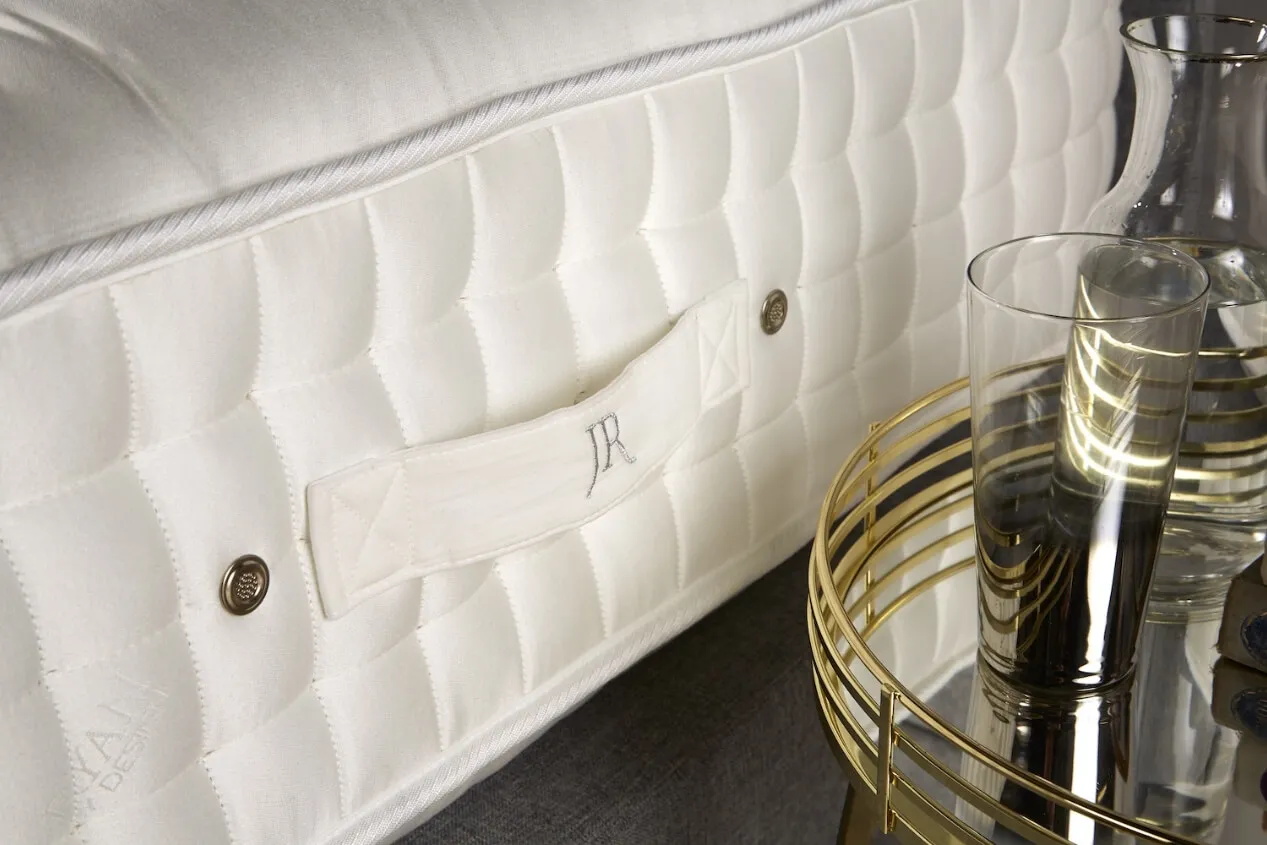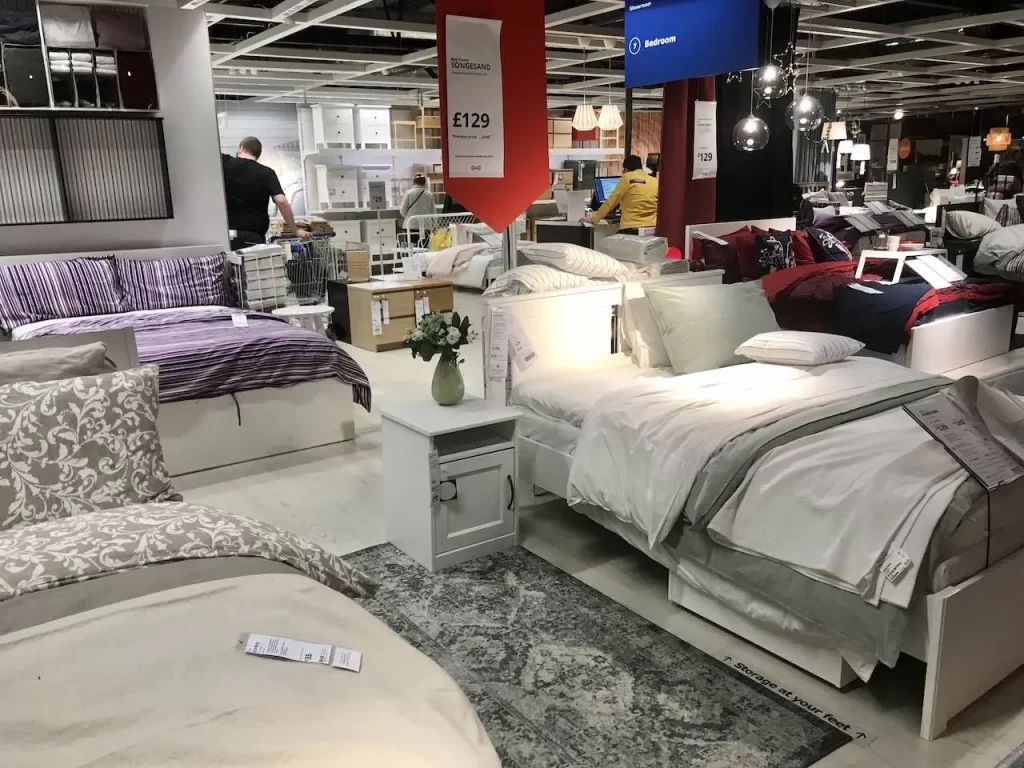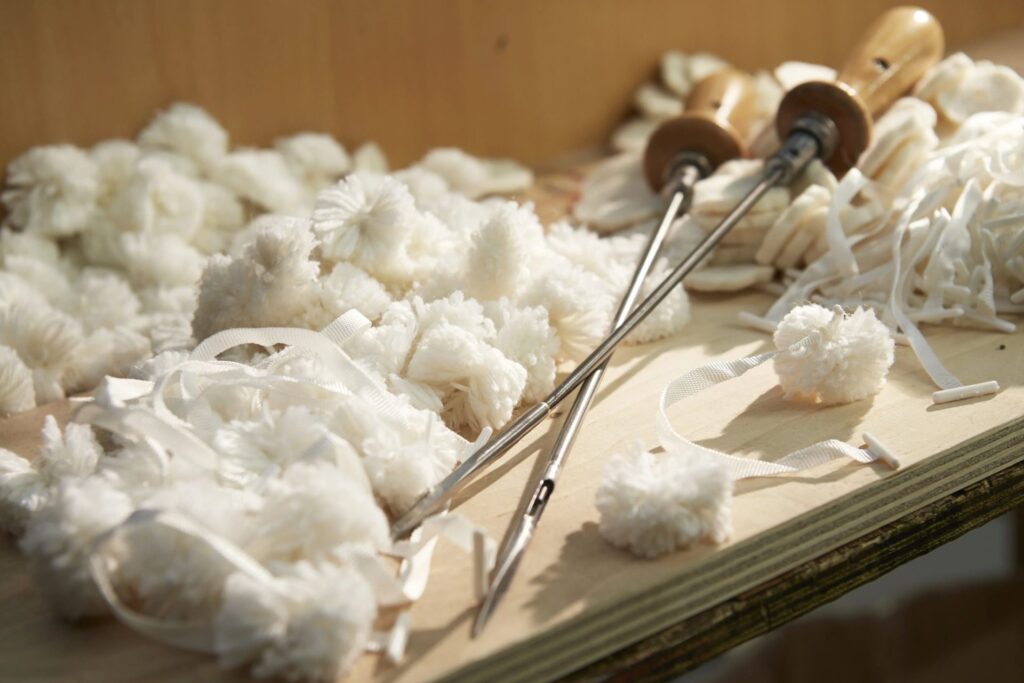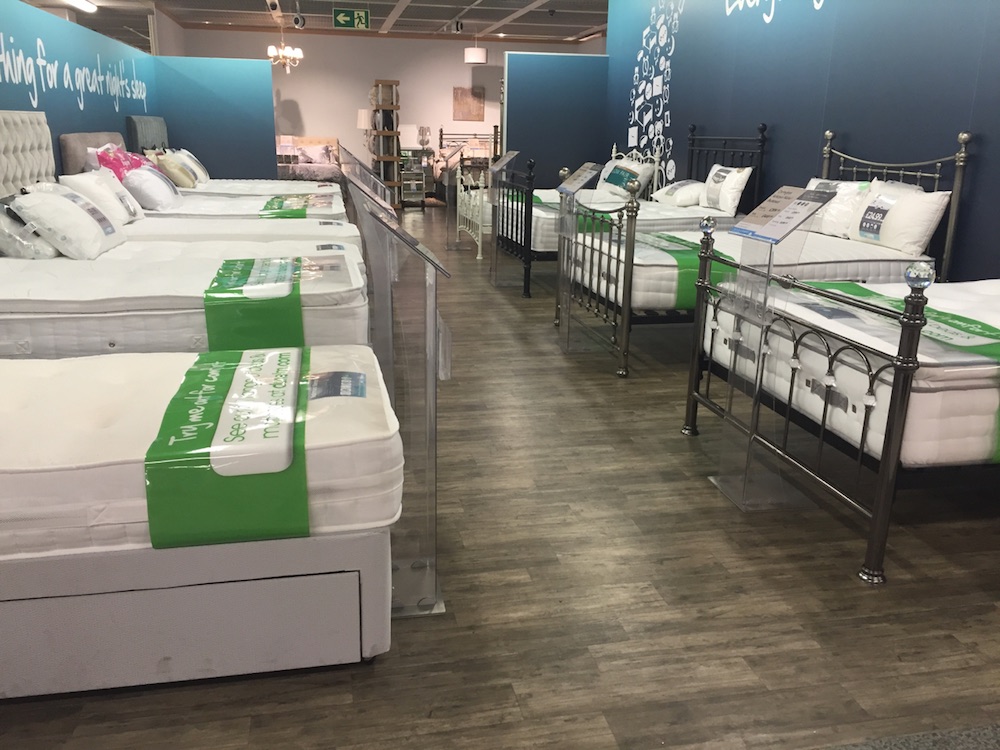Mattress Construction, Mattress Upholstery
March 2020What's inside my mattress? - Understanding the GSM of upholstery
Updated 2024: Would you believe it if we told you that the majority of mattress retailers withhold information from you when selling beds? Information that is crucial in the design and construction of mattresses is something that all mattress retailers will have, but they still decide not to share with you, the customer. This article lifts the covers on this murky practice and why you always need to ask ‘What’s the GSM of the fillings in this mattress?’.

You may have never seen GSM when mattress shopping, which goes to show just how secretive the mattress industry is. The finest examples of quality mattress manufacture like Savoir & Vispring always disclose the GSM of their mattresses, as do we with our entire range. Let’s look a bit further into what you really need to know about the GSM.
What is GSM in a mattress?
GSM stands for ‘Grams per square metre’ in upholstery terms. It refers to the actual weight of a particular upholstery component used within the mattress. It is a measurement used by all mattress manufacturers when purchasing upholstery and is used as a basis to establish the quality of a particular mattress. It is the weight of a square metre of material and it does not depend on type (Wool, Polyester, Horsehair) or how deep or fluffy something is. How thin or how bouncy the actual weight of a metre of the material remains constant.
This constant measurement of mattress fillings is known as the GSM (grams per square metre) as it is represented by a figure from 50gsm upwards. The higher the number, the more of that fibre the mattress contains.

It is also the weight of the entire depth of various upholstery components used directly on top of the springs, and this is known as the ‘combined upholstery weight GSM’. This is the weight in one square metre of all upholstery used in your mattress. If you know this GSM figure, you would be able to tell which mattress is better than another without even lying on it.
Unfortunately, you’ll notice that this figure is frequently left out of any product descriptions from mattress sellers. In fact, many mattress retailers themselves are rarely even given this vital piece of information by the manufacturers.
Knowing the grams per square metre allows you to know whats inside any mattress
Retailers want to keep this hidden so you can’t compare value


Knowing the GSM allows you to work out the mattress quality
The reason that manufacturers and mattress retailers hide the GSM is that they don’t want you to be able to make side by side comparisons between bed brands and mattress models. With this key bit of information missing, it means you will struggle to be able to properly compare and choose a new mattress. This way, salespeople in bed shops can push discounts, finance and other sales gimmicks at you, wearing you down until you pick whichever bed you ‘think’ is best. Wouldn’t it be best if you actually ‘knew’ which bed gave you the most for your money?
Take wool as an example.
- This comes in weights of 300 GSM / 600 GSM / 1200 GSM.
- You see two mattresses advertised as having wool upholstery.
- One has 1200 GSM wool as the upholstery. The other has just a miserly 300 GSM.
- They are both selling at £500.
Unless you know which mattress has the 1200 GSM wool, you will never know which was the better-built mattress for the same price.
The reason why so many manufacturers get away with not providing this figure is because they aren’t legally required to do so. When you’re left in the dark about the weight and breakdown of the upholstery layers, making an accurate comparison becomes pretty much impossible. The risk of you making the wrong decision and regretting your mattress purchase can be very high thanks to this shameful practice.

Is it really important to know GSM?
Absolutely it is. In fact, it’s so important for you to know it is very rarely mentioned in any mattress description you will see in the store or on the internet. This is the one thing manufacturers do not want you to know or ask about, and they rarely divulge this to the retailer, never mind the consumer. Yet retailers will have to have this information as this is the main way that you design a mattress. The GSM is not left to guesswork; it is carefully planned based on the feel of the mattress and the quality level it is going to be sold at. So beware retailers that tell you they don’t know. It would be impossible for them to make a mattress without knowing the GSM of each filling.
Once you read the explanation below, you will soon see that this blatant omission within many mattress descriptions is very evident.
What GSM should I look for in a mattress?
When looking for a new mattress you, quite rightly, want to get the most bang for your buck. Making sure when buying a new mattress that you’re choosing one with the most fillings. Significant mattress fillings will ensure your mattress lasts longer and doesn’t get as affected by settlement over time. Below is a table of roughly how much to expect in terms of overall total GSM for mattress price points. Obviously, different fibres have different price points, so it’s just a guide as to what you can expect.
| Mattress Price | Min GSM Amount | Example |
|---|---|---|
| £500 | 1000gsm | Origins Comfort 1000 |
| £750 | 1200gsm | Origins Pocket 1500 |
| £1000 | 1500gsm-2000gsm | Artisan 1500 |
| £1250 | 2000gsm-3000gsm | Artisan Naturals |
| £1500 | 3000gsm-4000gsm | Artisan Bespoke 004 |
| £2000+ | 3500gsm-6000gsm | Artisan Sublime |
We also have a ‘what to expect for your money’ table underneath. For example, you can see that a £500 mattress is going to contain primarily synthetic fibres, whereas a £2000+ mattress should contain primarily natural fibres.
| How much to spend on a double mattress? | What can I expect for my money? |
|---|---|
| Under £500 | Will not get you much at best a 13.5 gauge open coil/cage sprung with a thin polyester layer or a solid foam mattress. |
| £500 | Entry level spunbond springs with some form of synthetic upholstery. Usually one sided mattresses. |
| £750 | The beginnings of a basic pocket springs unit with 800 – 1000 count. No substantial amount of filling other than foams and synthetic materials. Two sided models. |
| £1000 | Should get you away from most low ranges and into the mid-range pocket spring models. |
| £1250 | Should get you a decent pocket sprung mattress with some Natural Fibre content. |
| £1500 | Should get you many manufacturers mid-range models with Natural Fibres |
| £1500-£2000 | Should get you a Hand Made primarily Natural Fibre Quality Mattress |
| £2000+ | You should expect 100% Natural Fibres and Traditional Hand Made Construction Method. |
| £5000+ | A Bespoke Hand Made Sleep System, High-end Spring Units & Featuring the Worlds Most Luxurious Natural Fibres. |
Finding out how much fibre is in your mattress is key to being able to compare its quality
Vague descriptions should be further investigated or avoided


So what is mattress GSM in simple terms?
Let us look at a typical real-life example. This is a description and specification of a mattress sold by Dreams Flaxby Nature’s Finest 16500 DNAir Mattress (Jan 2020 £2,499 Kingsize).
The product description states:
‘Our Natures Finest 16500 mattress uses Egyptian cotton, a durable filling that helps to keep you fresh and cool during the night as the material wicks potential moisture away from the body giving you that extra comfort benefit. Egyptian cotton has longer and finer strands than ordinary cotton, giving it a superior and more luxurious feel. The Natures Finest DNAir 16500 also includes layers of wool and hemp sourced from farms in and around Yorkshire. Using wool gives the mattress a soft, springy and naturally supportive feel whilst also possessing anti-bacterial properties. Other layers include mohair, which has a slightly softer and smoother texture than wool but still provides great strength with a more luxurious and silky feel.’
Advertised Specifications:
- 16,500 pocket spring (made up of HD springs more on them here)
- Key fillings: Egyptian cotton – Wool and Hemp – Mohair
- Hand-tufted mattress panel Double-sided
- Pillowtop construction (read more here on why you want to avoid that)
- Comfort Grade: Soft-Medium

What you need to know to see where your money is going
We know that it contains 16,500 springs and, given we already know that the maximum amount of springs in a kingsize mattress is 2,000, they must be using multiple layers of Micro or HD springs. However, the upholstery is the most interesting part and the lack of detail on the fillings. The description states quite clearly “layers” what exactly is the amount in these ‘layers’?
The specification tells you that the key fillings are Egyptian cotton – wool blended with Hemp and Mohair – but how do you actually know that this is true? Don’t just take the above description as being what you ‘think’ you will be getting.
The above is all the information this particular retailer decides to give you. But remember, they are asking about £2,499 for this particular mattress, so you absolutely need to know where your money is going? We also know that you should be expecting 3,000+ total GSM for a mattress like this.
How can I tell what is in a mattress?
The best way is to either directly ask the salesperson or get in touch with the brand to ask. Alternatively, we have over 200 mattress models in our Mattress Comparison tool where we have found out the GSM to save you the time.
We’re going to show you with five questions how you can check what’s inside a mattress. Using the example above, these are the questions we would pose to this particular retailer. This will explain in detail what you are up against.
1. What is the combined upholstery weight of the mattress?
The combined upholstery weight is the total weight of all the fillings used in a square metre of the mattress upholstery. If we take for granted that for this retail price you should be looking at around 3000 GSM of premium upholstery, this description tells you very little. In reality, it could be a paltry 1000GSM and you will have no recourse because you weren’t told otherwise. Sometimes, a good way to check the GSM of a mattress is to find out the total weight of the mattress in a king size. If it’s only 35kg, for example, it’s going to be super light touch: maybe 1000gsm. However, if it’s 75kg then it should contain roughly 3000-3500 gsm.
2. Is there polyester in the mattress?
Polyester is amongst the cheapest mattress components you can get. Usually, it’s given names like premium white fibre or anti-allergenic white fibre, but it is still polyester and it is still cheap. If this component forms the bulk of the upholstery you are paying top-whack for a cheap mattress. However, we don’t know for sure if there’s polyester in this mattress as, although it has natural in the title, there’s no reference to 100% Natural fibres. The minimum would be 300GSM and the likely maximum 1500GSM, which is probably used in the pillowtop of this mattress to give it the loft it requires.

3. What is the GSM of the Egyptian cotton?
Take note that on the description given, the Egyptian cotton GSM is missing. It is quite rare for cotton to be used as a stand-alone component (it is not fire retardant) and usually forms part of a blend. In this case, it is likely that the polyester/cotton is a component known as RPC (rebound poly cotton): not a bad component, but not premium either. Egyptian cotton is super soft with high loft but also high compression. This means it flattens really quickly unless it’s blended with another fibre to give it more rigidity in a mattress comfort layer. This comes in weights of 300GSM, 600GSM and multiples thereof. As no GSM is given, you can be buying a paltry 300GSM or an acceptable 1200GSM. You don’t know!
4. What is the GSM of the Wool & Hemp blend?
Again, it’s the same story. There’s absolutely no detail given as to the GSM or blend of this fibre. Is this the top comfort layer or buried further into the mattress? Is this a 300gsm thin pad of a 2000gsm thicker layer? Also wool & hemp have two very different properties. Wool is incredibly soft with high loft, whereas hemp is a very flat, firmer fibre with low loft. It’s usually used to firm up mattress upholstery. So they are in direct odds with each other.

If you see the description of wool, silk and cashmere on a product description you can assume it is there to make the mattress look as though it is packed with premium components. However, without a gsm weight attached the actual weight could be so minimal that it is worthless.
5. What is the GSM of the Mohair?
Mohair is a premium component and this is more than likely to be used as the spring insulator. The description as “softer than Wool” is a little misleading, as usually Mohair in mattress construction is used as a firmer breathable layer in a mattress like in our Artisan Tailored Pocket 2000. Being part of a blend, say with pure new wool, you will then have to know the ratio. Mohair is expensive, so don’t be surprised if the ratio of Mohair is as little as 5% of the entire GSM. The fact that it can legally be included within a product description has more value than the component itself.

And that’s it. A little scratch on the surface – which from a simple description and basic specification of a mattress that is retailing at £2499 or so – opens up a complete minefield of questions and doubt. This is a classic example of why you are going to find purchasing a mattress so ridiculously hard. If you can find out the GSM, you’re in a far stronger position to choose the correct mattress for your needs.
There is no legal requirement for a manufacturer or retailer to divulge the contents by weight to you, but that does not make it right. Looking at the description above even we cannot tell you what the weight and breakdown of the upholstery layers are – they are complete unknowns and, without you knowing what these are, it becomes quite impossible for you to do any kind of comparison to other models. And this is the sole reason why this shameless practice is carried on.
There is no legal requirement for a manufacturer or retailer to divulge the contents
How much do mattress natural fibres cost?
We’ve put together a handy table below to help you get an idea of just how expensive certain fibres are. This will help you work out whether that mattress ‘deal’ you’ve seen can really contain the ‘vague’ natural fibres it lists, keeping you one step ahead of the shady tactics.
| Natural fibre | Cost / Availability |
|---|---|
| Alpaca | Very expensive (low supply chain) |
| Bamboo | Average price (good supply chain) |
| Camel | Very expensive (low supply chain) |
| Cashmere | Expensive (good supply chain) |
| Cattle Hair | Average price (good supply chain) |
| Coir | Average price (good supply chain) |
| Cotton | Very expensive (good supply chain) |
| Flax | Average price (good supply chain) |
| Hemp | Average price (good supply chain) |
| Horsetail | Very expensive (low supply chain) |
| Horsehair | Less expensive (good supply chain) |
| Mohair | Expensive (low supply chain) |
| Silk | Very expensive (low supply chain) |
| Vicuna | Very Expensive (Most expensive natural fibre in the world) |
| Wool | Moderate to expensive (good supply chain) |
Summary
Once you understand what to look for you will be skimming through descriptions like a demon and quite enjoy spotting the misleading and dubious specifications you come up against. But there really should be no reason why you should go to these extraordinarily long lengths having to play Sherlock Holmes and phoning manufacturers to ask the necessary details on upholstery before you hand over hundreds or even thousands of pounds for your mattress. To be honest, it’s absolutely disgraceful that you will have to do this to compare.
The GSM value of upholstery is the one thing 99% of ALL manufacturers do not want you to know.
We hope that manufacturers and retailers will eventually tire of the calls and questions and list their products the same way as food manufacturers do with a completely itemised summary showing component and weight.
If you want to find out what’s inside a mattress why not give our expert team a call on 0161 437 4419 or drop us a message below. You can also use our Mattress Comparison tool which details the GSM of over 200 retail models.

Dreaming of the perfect nights sleep?

Ask us a question
There are over 6000 questions and answers submitted by you on all questions about mattresses and bed problems. Enter a keyword such as Vi Spring, John Lewis beds, bad back or Memory Foam and see if your question has already been answered.
If you can’t find an answer in knowledge hub, ask a new question. We aim to respond to all questions within one working day.
Newsletter
Enter your email to join our newsletter. We’ll send you occasional news and mattress expertise.
